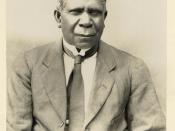AUSTRALIA IN THE 1940s AND 1950s
Reflections
Australia was a very different country from what it is today.
The population was much smaller and people were still recovering from the Second World War. Australia's population was only about 7 500 000, less then half of what it is today. 90% of the Australian population had been born here and most were descended from the English, Irish or had a Scottish background.
The immigration scheme which began after the Second World War did not greatly change the cultural mix of the population, for initially it only involved British migrants.
In 1947 the scheme was to extend and include other members of the British Empire and Americans who had served in the war.
These early post-war migrants were often held in suspicion by older Australians. They were un-use to cultural differences and sometimes saw migrants as a threat to their jobs and the Australian way of life. There was fear that immigration would create unemployment.
Throughout the 1950s unemployment was low, rarely rising above 2%. Wages were lower than today, but life was also much simpler and cheaper than today.
Unfamiliar migrants and the low cost of living were only two aspects of life in the 1940s and 1950s that are unrecognisable to us today.
From the first European settlement, Australia was viewed by colonists and evolutionists as terra nullius, 'a land without people or culture - ripe for exploitation.
Aboriginal history from white settlement in 1788 to the late 20th century is a catalogue of injustice and tragedy.
Violent battles over rights to land, food and water sources characterised race relations in the nineteenth century. Throughout this conflict indigenous children were kidnapped and exploited for their labour. Governments and missionaries also targeted indigenous children for removal from their families. There...



Missed Alot
You have missed a lot of important information out in this essay! How did the Australian population start to increase? Because the government started to allow people into the country that were not of anglo saxan origins. They also lost the yellow peril attitude and started to let people in from singapore, malaysia, indonesia and such? Why did they do this? How did imigrants contribute? Snowy Mts water scheme. There is so much more that you could have added in to make this essay a lot more appealing to a marker. Dont jump straight from how immigrants were treated into the treatment of Aborigines, you lose the reader when you do this. Try again.
4 out of 4 people found this comment useful.